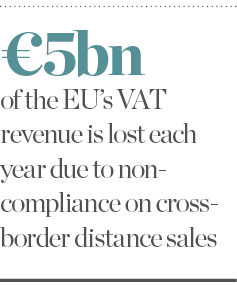
Many CEOs have been left feeling uneasy by the countless tax policy changes proposed or enacted by national and international authorities. In fact, in PwC’s 22nd Annual Global CEO Survey, CEOs named overregulation as the number one threat to business, with an increasing tax burden identified as the seventh-greatest danger. Meanwhile, CEOs and board members surveyed in the Executive Perspectives on Top Risks 2019 report, a joint study conducted by North Carolina State University and global consulting firm Protiviti, cited regulatory changes and scrutiny as one of the top three risks to business in 2019.
These worries stem from the fact that proposed tax rules could require executives to make significant adjustments to their existing business models, enterprise resource planning systems and related business processes. Managing the anxiety surrounding these changes can be difficult, especially given the uncertainty regarding digital taxation, continual adjustments to the EU’s value-added tax (VAT) system and the unfolding impacts of the US Supreme Court’s verdict on internet sales tax. With these issues in mind, additional tax policy transformations appear to be a matter of when, not if.
Change is afoot
Although the digital VAT package adopted by the EU in December 2017 contains a number of changes that went live earlier this year, its most wide-ranging rules are primarily focused on B2C e-commerce transactions, and will begin to take effect in 2021.
Most tax leaders and their teams have already addressed the 2019 digital VAT package changes, which include a taxation-at-origin stipulation, an easier approach to determining customer location, a simplified registration process and a number of invoicing alterations. There is no time for complacency, however, and CEOs must be equally forward-looking with impending developments.
The biggest change set to take effect in 2021 will be the elimination of the EU distance-selling regime. Under the current protocol, businesses with a turnover in excess of €100,000 – or €35,000, depending on the country – must register in every member state where they sell goods to consumers.
By identifying and assessing the impact of tax policy changes early, companies can minimise the uncertainty caused by alterations
This rule has significantly increased operating costs for businesses engaged in sales within the EU, prohibiting growth among small to medium-sized e-commerce firms. For every EU country in which they sell goods, these organisations must pay around €8,000 in VAT compliance costs. It is estimated that €5bn of VAT revenue is lost each year in the EU due to non-compliance on cross-border distance sales.
As of January 1, 2021, though, the distance-selling regime will no longer apply. Instead, businesses will be able to fulfil all VAT obligations relating to cross-border sales in one member state via the VAT Mini One Stop Shop (MOSS) scheme. By proactively recognising the impacts of these imminent changes, CEOs and tax leaders can free up time to adjust to the other major tax policy alterations looming on the horizon.
Transforming the policy landscape
Another measure that will be removed by the EU in 2021 is the low-value consignment exemption. Currently, imported goods with a total value under €10 or €22 (again, depending on the country) are exempt from VAT. As this exemption gives preferential treatment to suppliers of low-value goods that are produced in developing countries, the EU has decided to abolish it starting January 1, 2021. Moving forward, a hybrid system will be put in place for the import of goods valued up to €150.
Under the new system, non-EU suppliers selling goods to European customers will have the option to register in one member state and pay VAT monthly through the MOSS scheme. If the transaction is facilitated by a platform, said platform will be responsible for VAT remittance; if no platform is involved and the supplier does not choose to use the MOSS scheme, the transporter of the goods will be responsible for collecting and paying VAT.
A provision establishing the tax liability of online platforms is another key element of the digital VAT package. With the majority of cross-border sales taking place via online marketplaces, the EU is intent on involving these platforms in the collection of VAT for the transactions they facilitate.
According to the new rules, a platform will be deemed the supplier if it is involved in the importation of B2C goods valued under €150 or the sale of goods by non-EU businesses inside the EU. In other words, the online platform will become liable for the collection and remittance of this VAT to the tax administration. These provisions will apply regardless of whether the platform is based in the EU or not.
Quick fixes
In addition to making the European VAT system fit for purpose in the digital economy, the EU sees an urgent need to address VAT challenges on cross-border trade inside the bloc. In October 2018, the EU approved several quick fixes that will be applied from January 1, 2020.

Currently, businesses engaged in trade across the EU incur compliance costs that are 11 percent higher than those trading within only one EU country. The main factors driving these extra costs are the different applications of the VAT rules among EU member states and the additional compliance obligations for businesses engaged in cross-border trade. According to the EU, the goal of their quick fixes is to establish “harmonised rules” that will “enhance legal certainty” for businesses engaged in intra-EU trade.
The first of these fixes is to implement uniform rules for call-off stock arrangements – agreements wherein a supplier makes items available to the customer by delivering them to a location nearby. In this arrangement, the supplier retains ownership of the goods during their storage, but the customer is entitled to take items from the stock as and when they are needed. Under the new rules, the transfer of goods to call-off stock warehouses in different member states will be ignored for VAT purposes. Additionally, the supplier will not have to register in the member state where the stock is located.
Uniform rules will also be put in place for chain transactions. These will apply to successive supplies of goods that are delivered by various taxable parties despite the goods only being transported once to the final purchaser. The EU’s quick fix determines which part of the chain is responsible for transport in the event that a third party has arranged delivery. Unfortunately, current EU VAT legislation does not address this issue, and instead businesses are forced to rely on complex rules established by the EU’s Court of Justice.
Finally, the third and fourth quick fixes will apply to compliance obligations for traders who supply goods to business customers within the EU. As a result of these changes, suppliers will need to provide the customer’s VAT identification number in order to benefit from any exemptions. The new rules also specify which documentary evidence will be required to exempt intra-EU supplies.
CEOs concerned about tax compliance burdens are best served by proactively addressing any new tax requirements. By identifying and assessing the impact of looming tax policy changes early, companies can minimise the uncertainty caused by alterations to the status quo. Given the volume and magnitude of the unknowns currently surrounding tax policy, this clarity will be incredibly valuable.

